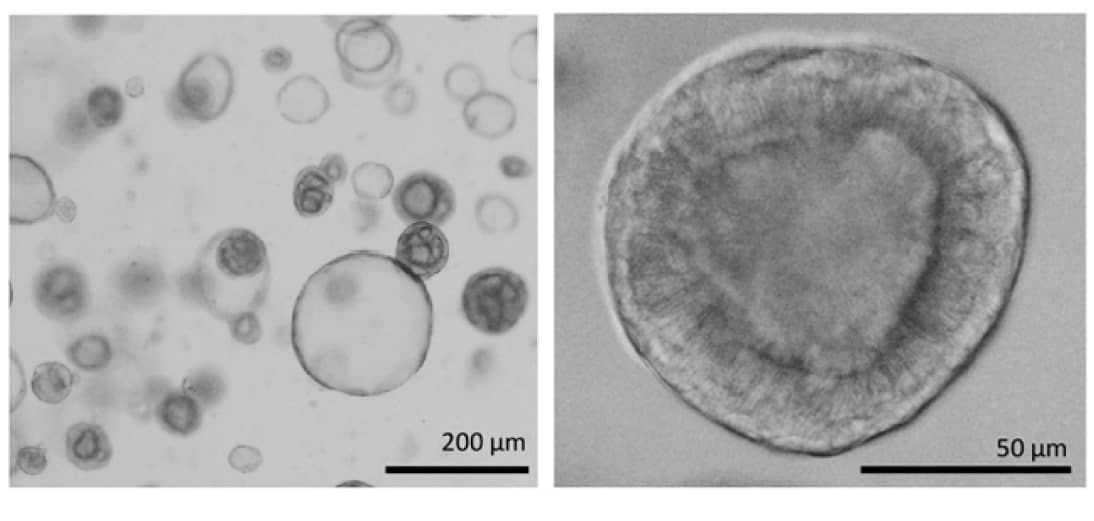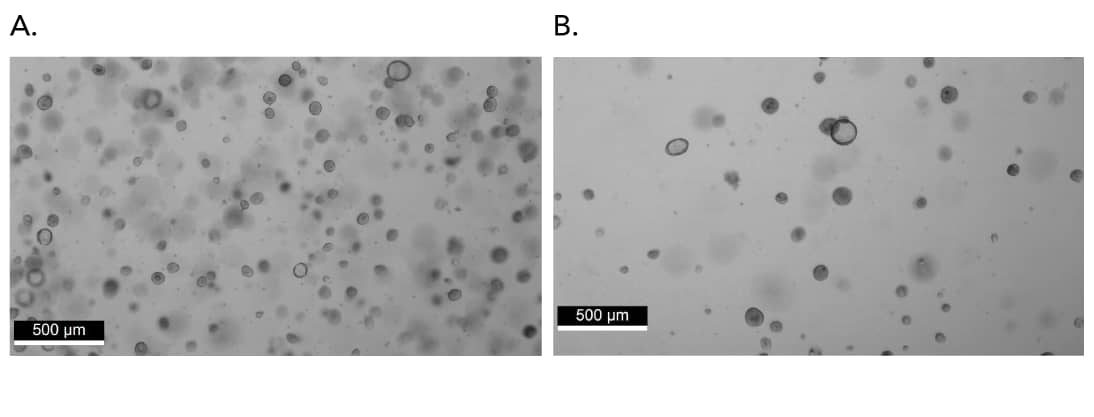Human Lung Organoid Culture Protocol
Introduction
This protocol provides a procedure for subculturing and expanding human lung organoids. It was modified from the methods described in a publication by Sachs, N. et al. (2019) Long-term expanding human airway organoids for disease modeling. EMBO J. 34:e100300.
Lung organoids have been widely used for exploring lung development, modeling host-pathogen interactions, studying pulmonary diseases, understanding lung repair mechanisms, and screening drug candidates. The procedure outlined below is intended to serve as a guide for the long-term culture of lung organoids from normal human lung tissues using Cultrex™ UltiMatrix Basement Membrane Extract as a scaffold. The majority of the reagents used in this protocol were sourced from the Bio-Techne brands of R&D Systems and Tocris Bioscience.
Equipment
- Cell culture incubator (37 °C, 5% CO2)
- Cell culture hood with laminar flow
- Centrifuge with refrigeration and swinging bucket rotor
- 37 °C water bath
- Ice bucket
- Laboratory refrigerator
- Pipet aid and serological pipettes (5 mL)
- Micropipettes and tips (2–200 μL)
- Conical tubes, 15 mL and 50 mL, sterile
- 24-well plate, tissue-culture treated, sterile
- Vacuum pump
- Medium filtration unit, 0.1 μm, 500 mL, sterile
- Syringe, 50 mL, sterile
- Syringe filter, 0.2 μm, sterile
- Cell culture waste container
Other Required Reagents
- Distilled (DW) or deionized water (DI)
- Phosphate buffered saline (PBS)
Materials
TABLE 1. Materials Needed for Human Lung Organoid Culture
Product Name | Supplier | Catalog # |
| Cultrex Organoid Harvesting Solution | R&D Systems | 3700-100-01 |
| Cultrex UltiMatrix Reduced Growth Factor Basement Membrane Extract | R&D Systems | BME001-05 |
| Advanced DMEM/F-12 Cell Culture Medium | Thermo Fisher | 12634010 |
| GlutaMAXTM | Thermo Fisher | 35050061 |
| HEPES | Tocris Bioscience | 3173 |
| N21-MAX Supplement | R&D Systems | AR008 |
| N-Acetylcysteine | Tocris Bioscience | 7874 |
| A 83-01 (ALK5 inhibitor) | Tocris Bioscience | 2939 |
| Penicillin/Streptomycin | Various | Various |
| SB 202190 (p38 MAPK inhibitor) | Tocris Bioscience | 1264 |
| Nicotinamide | Tocris Bioscience | 4106 |
| Y-27632 dihydrochloride (Rho Kinase inhibitor) | Tocris Bioscience | 1254 |
| Recombinant Human R-Spondin 1 | R&D Systems | 4645-RS |
| Recombinant Human Noggin | R&D Systems | 6057-NG |
| Recombinant Human FGF-10 | R&D Systems | 345-FG |
| Recombinant Human FGF-7 | R&D Systems | 251-KG |
Reagent Preparation
Use aseptic technique at all times during this protocol. This protocol is optimized for human lung organoids; organoids from other tissues may have different culture requirements.
1. Thaw Cultrex UltiMatrix RGF Basement Membrane Extract (BME) on ice for four hours or overnight at 2 - 8 °C (on ice in the refrigerator).
2. Prepare Lung Organoid Expansion Medium, as indicated in TABLE 2.
3. Sterile filter the media
TABLE 2. Preparation of Human Lung Organoid Expansion Medium
Reagent Name | [FINAL] |
| Advanced DMEM/F-12 Cell Culture Medium | N/A |
| N21-MAX Supplement | 1X |
| GlutaMAX | 2 mM |
| HEPES | 10 mM |
| Penicillin/Streptomycin | 1X |
| Nicontinamide | 5 mM |
| A 83-01 | 0.5 µM |
| SB 2020190 | 0.5 µM |
| Y-27632 dihydrochloride | 5 µM |
| N-Acetylcysteine | 1.25 mM |
| Recombinant Human Noggin | 100 ng/mL |
| Recombinant Human FGF-10 | 100 ng/mL |
| Recombinant Human FGF-7 | 25 ng/mL |
| Recombinant Human R-Spondin 1 | 0.5 µg/mL |
Methods for Culturing and Expanding Human Lung Organoids
1. Prepare a suspension of isolated and dissociated human lung tissues as detailed in Sachs, N et al. (2019) Long-term expanding human airway organoids for disease modeling. EMBO J. 34:e100300.
2. Resuspend lung tissue cell pellet in Cultrex UltiMatrix RGF Basement Membrane Extract (BME) and aliquot into wells by dispensing 50 μl of the Cultrex UltiMatrix RGF BME/cell suspension mixture in the center of each well of a 24-well plate. Note: The Cultrex UltiMatrix RGF BME-contained organoids should not touch the sides of the well.

FIGURE 1. Placement of Cultrex UltiMatrix RGF BME/Organoid Mixture in a 24-well or 6-well Plate. (A) Placement of Cultrex UltiMatrix RGF BME/organoid mixture in the center of the well of a 24-well plate or (B) placement of multiple domes within a well of a 6-well plate.
3. Incubate the plate in the cell culture incubator for 15 minutes to polymerize the Cultrex UltiMatrix RGF Basement Membrane Extract.
4. Add the appropriate volume of Lung Organoid Expansion Medium needed (approximately 500 μL/well of a 24-well plate). Note: Medium should be gently aspirated from the corner of the well away from the Cultrex UltiMatrix RGF BME/organoids to prevent their disruption.
5. Return plate containing organoid cultures to the cell culture incubator to promote growth.
6. The culture medium should be aspirated from each well and replaced with fresh Lung Organoid Expansion Medium every 2-3 days. Note: Medium should be gently aspirated from and pipetted into the corner of the well away from the Cultrex UltiMatrix RGF BME/organoids to prevent their disruption.
7. Organoids can be passaged for continued culturing (see Passaging Lung Organoids section).

FIGURE 2. Human Lung Organoids Grown in Cultrex UltiMatrix RGF BME. Representative images of lung organoids, derived from lung biopsy adult stem cells, embedded in Cultrex UltiMatrix RGF BME (R&D Systems, Catalog # BME001-05) and cultured in Lung Organoid Expansion Media. Images show organoids at day 52 of culture.
FIGURE 3. Characterization of Human Lung Organoids. Adult stem cells isolated from human lung biopsy tissue were embedded in Cultrex UltiMatrix RGF Basement Membrane Extract (R&D Systems, Catalog # BME001-05) and cultured in media for 20-60 days. Lung organoids were able to differentiate and exhibit markers for various cell types of the lung. Lung organoids were stained with (A) a Rabbit Anti-Human Cytokeratin 5 (KRT5) Monoclonal Antibody (Novus Biologicals, Catalog # NB110-56916; green) and a Goat Anti-Human p63/TP73L Polyclonal Antibody (R&D Systems, Catalog # AF1916; red) to visualize basal cells, (B) a Hamster Anti-Mouse Podoplanin (PDPN) Monoclonal Antibody (Novus Biologicals, Catalog # NB600-1015; green) to visualize alveolar type I cells and a Goat Anti-Human p63/TP73L Polyclonal Antibody (R&D Systems, Catalog # AF1916; red) to visualize basal cells, and (C, D) a Mouse Anti-MUC5AC Monoclonal Antibody (Novus Biologicals, Catalog # NBP2-15196; green) to visualize Goblet cells and a Mouse Anti-Human/Mouse/Rat SOX2 Monoclonal Antibody (R&D Systems, Catalog # MAB2018; red). All samples were counterstained with the nuclear stain DAPI (Tocris Bioscience, Catalog # 5748; blue).

Passaging Lung Organoids
1. View lung organoids under the microscope. Each well should contain approximately 500 organoids for optimal growth. Organoid cultures exhibiting rapid growth may be split 1:4 during passaging, while slow growing cultures may benefit from a 1:1 split. Make this determination prior to harvesting to estimate reagent needs prior to starting. Note: Organoid density is important for optimal growth; too many organoids will strain culture resources, while too few organoids lack paracrine signaling necessary to sustain growth.
2. Transfer the 24-well plate containing lung organoids from the cell culture incubator to the cell culture hood.
3. Aspirate the medium without disturbing the Cultrex UltiMatrix RGF BME-contained organoids at the bottom of the well.
4. Gently wash each well with 10 volumes of cold (2-8 °C) PBS (TABLE 3). Be careful not to disrupt basement membrane matrix containing organoids.
TABLE 3. Suggested Volumes of PBS and Organoid Harvesting Solution
Plate Type |
Volume of Basement Membrane Matrix |
Volume of PBS and Organoid Harvesting Solution |
| 96-well plate | 5 µL | 50 µL |
| 48-well plate | 25 µL | 250 µL |
| 24-well plate | 50 µL | 500 µL |
5. Aspirate the PBS and add 10 volumes of cold (2-8 °C) Cultrex Organoid Harvesting Solution to each well (TABLE 3).
6. Incubate the plate at 2-8 °C or on ice for 30–90 minutes with moderate shaking. This incubation is complete when the basement membrane matrix dome is no longer visible at the bottom of the well and the organoids are seen floating at the bottom of the well. Note: Dislodging the dome with a cell scraper or pipet may accelerate this process.
7. Once the matrix depolymerizes, transfer contents of the well into a tube on ice. Single wells may be transferred to a microtube while multiple domes may necessitate a 15 mL or 50 mL conical tube.
8. Centrifuge the tube at 500 x g for 5 minutes at 2-8 °C in a swinging bucket rotor to pellet the organoids. Aspirate the supernatant.
9. Wash organoids with 10 volumes of cold (2-8 °C) PBS and repeat centrifugation at 500 x g for 5 minutes at 2-8 °C in a swinging bucket rotor to pellet the organoids. Aspirate the PBS. Add fresh ice-cold Lung Organoid Expansion Medium.
10. Pipet up and down three times with a serological pipette to mix the organoids.
11. Centrifuge the tube at 500 x g at room temperature for 3 minutes.
12. Aspirate the medium but be careful not to disturb the organoid pellet.
13. Resuspend organoids in Cultrex UltiMatrix RGF Basement Membrane Extract and dispense 50 μL of the mixture in the center of each well of a 24-well plate to form domes. Follow the density/splitting ratios recommended in Passaging Protocol Step 1. Note: The Cultrex UltiMatrix RGF BME domes should not touch the sides of the well.
14. Incubate the plate in the cell culture incubator for 15 minutes to polymerize Cultrex UltiMatrix RGF Basement Membrane Extract.
15. Add 500 μL of Lung Organoid Expansion Medium per well. Note: Medium should be gently pipetted into the corner of the well away from the Cultrex UltiMatrix RGF BME/organoids to prevent their disruption.
16. Return plate containing organoid cultures to the cell culture incubator to promote organoid growth. Follow Lung Organoid Expansion Protocol.

FIGURE 4. Density of Lung Organoids Following Expansion and Passaging. Lung organoids were expanded using Lung Organoid Expansion Medium for 25 days prior to passaging. Representative brightfield images demonstrating the density of human lung organoids (A) before and (B) after passaging.
-
Sachs, N. et al. (2019) Long-term expanding human airway organoids for disease modeling EMBO J. 34:e100300. PMID: 30643021.